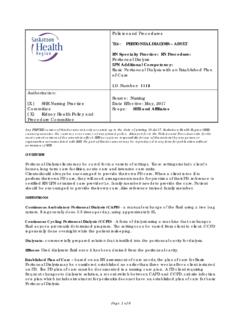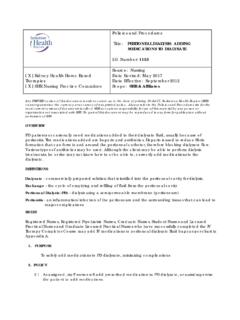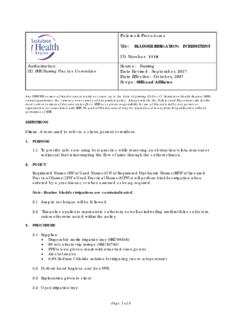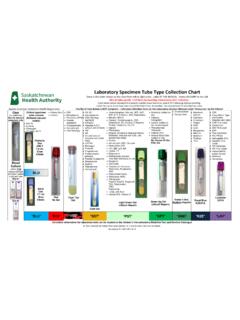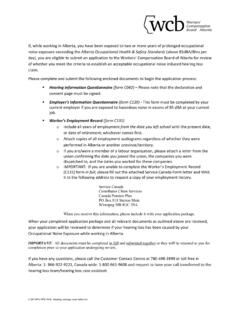Transcription of NASOGASTRIC/OROGASTRIC TUBE: INSERTION, CARE OF, …
1 Page 1 of 14 Any PRINTED version of this document is only accurate up to the date of printing 20-Nov-17. Saskatoon Health Region (SHR) cannot guarantee the currency or accuracy of any printed policy. Always refer to the Policies and Procedures site for the most current versions of documents in effect. SHR accepts no responsibility for use of this material by any person or organization not associated with SHR. No part of this document may be reproduced in any form for publication without permission of SHR. HIGH ALERT - Inadvertent placement in the trachea can lead to severe complications: pleural injury, pneumothorax, tracheobronchial aspiration, pneumonia, and death if fluids or other agents are infused (Walsh et al, 2016). DEFINITIONS Levine Tube: a one-lumen NASOGASTRIC/OROGASTRIC tube.
2 It is usually made of plastic with several drainage holes near the gastric end of the tube. This nasogastric tube is useful in instilling material into the stomach. Nasogastric (NG) tube: a tube that is passed through the nose and down through the nasopharynx and esophagus into the stomach Orogastric (OG) tube: tube that is passed through the mouth and down through the oropharynx and esophagus into the stomach Salem-sump: is a two-lumen NASOGASTRIC/OROGASTRIC tube. The dual lumen tube allows for safer continuous and intermittent gastric suctioning. The large lumen allows for easy suction of gastric contents, decompression, irrigation and medication delivery. The smaller vent lumen allows for atmospheric air to be drawn into the tube and equalizes the vacuum pressure in the stomach once the contents have been emptied.
3 This prevents the suction eyelets from adhering to and damaging the stomach lining. ROLES Graduate Nurse (GN) and Graduate Licensed Practical Nurse (GLPN): GNs and GLPNs may insert, care for and remove NASOGASTRIC/OROGASTRIC tubes, according to physician orders, and under supervision of an RN or LPN until deemed competent to provide care autonomously. Most Responsible Physician (MRP) or designate: MRPs will provide orders for the insertion, use and removal of NASOGASTRIC/OROGASTRIC tubes, x -ray if needed, and will document results of any x-ray confirmation of tube placement. Policies & Procedures Title: NASOGASTRIC/OROGASTRIC TUBE: INSERTION, CARE OF, AND REMOVAL Adult Number: 1040 Authorization: [X] SHR Nursing Practice Committee [X] Interprofessional NG Tube Safety Working Group Source: Nursing Date Revised: October 2017 Date Effective: May 1999 Scope: SHR Acute Care Policy and Procedure: NASOGASTRIC/OROGASTRIC Tube: Insertion, Care Of and Removal # 1040 Page 2 of 14 Registered Nurse (RN) and Licensed Practical Nurse (LPN): RNs and LPNs, including those LPNs who graduated prior to 2008 and have completed the SaskPolytechnic NG Completer Course, may insert, care for and remove NASOGASTRIC/OROGASTRIC tubes, according to physician orders.
4 1. PURPOSE To minimize risk of aspiration and other complications associated with NASOGASTRIC/OROGASTRIC tube insertion and use. To provide consistent best practice guidelines for management of a NASOGASTRIC/OROGASTRIC tube. 2. POLICY NASOGASTRIC/OROGASTRIC tubes are used: To remove fluid and gas from the gastrointestinal tract To obtain a specimen of gastric contents To treat gastric immobility and bowel obstructions To allow for drainage and/or lavage in drug overdoses or poisonings For short term medication administration and short term feeding The Most Responsible Physician ( MRP) or designate writes orders: Written Order Required: To insert, irrigate and/or remove a nasogastric (NG)/ orogastric (OG) tube For x-ray to confirm tube placement when unable to confirm tube placement with pH testing.
5 Requisition MUST indicate reason for X-ray ( Chest X-ray for confirmation of gastric tube placement). The MRP or designate may confirm placement based on a review of the x-ray. It is the responsibility of the MRP or designate to consult with radiology should there be any doubt with respect to placement For the type and amount of suction For gastric fluid replacements; should include route, solution type and additive, volume/rate and duration time for replacement For short term feedings NG/OG tube placed intraoperatively: The Surgeon has confirmed placement by direct visualization or palpation, an order will be written that confirmation of placement was done and tube may be used. An additional order may be written that pH testing is not needed, and placement will be checked by doing Clinical Assessment (see ) Policy and Procedure: NASOGASTRIC/OROGASTRIC Tube: Insertion, Care Of and Removal # 1040 Page 3 of 14 The correct gastric placement of NG/OG tubes will be confirmed: By pH testing of aspirate, regardless of the purpose of the tube on insertion, as well as prior to instilling any feeding or medication.
6 Exception: for a special circumstance where pH may not be reliable, an alternate method of checking placement may be used ( patient on continuous feeds, or patients taking acid reducing medication). Refer to to By Clinical Assessment: Which is done on tube insertion as well as prior to instilling any feed or medication, and placement must be checked minimally every shift by Clinical Assessment. The Clinical Assessment includes all of the following: Client is tolerating the NG/OG, the NG/OG is working properly (for suction or feeds), no coiling of tube in mouth, no unexplained respiratory distress, absence of unexplained cough, no drop in oxygen saturations if being monitored, absence of vomiting or retching, and insertion length of NG/OG has not changed.
7 By x-ray: If unable to obtain aspirate (to test pH), or the pH is above the expected range - at the discretion of the MRP. At the discretion of the physician when placement of NG is in doubt By visualization or palpation for tubes placed intra-operatively by the surgeon Special Considerations A Nasogastric / Orogastric Tube will not be inserted if: The patient has or is suspected to have a basal skull fracture or cribriform plate fracture - both NG/OG tubes There is danger of perforation with patients who have had recent esophageal surgery / repair, esophageal varices, esophageal strictures, esophagectomy, recent gastric surgery, gastrectomy, recent throat surgery. Check with MRP prior to insertion - both NG/OG tubes The patient has facial fractures or recent surgery to ear, nose , throat , or jaw.
8 Check with MRP or ordering Physician prior to insertion - both NG/OG tubes The patient has severe coagulopathies. It is recommended to check INR/PTT, hemoglobin a nd platelets prior to procedure - both NG/OG tubes Large bore NG/OG tubes are not recommended for enteral feeding. Small bore feeding tubes should be used instead. Please see the following policies: Enteral Feeding Tube with a Stylet: Assisting with Insertion of, Care of, Removal of- #1109 Enteral Tube Feeding - Adult # 1020 Enteral Tube Feeding - Pediatrics # 1026 Policy and Procedure: NASOGASTRIC/OROGASTRIC Tube: Insertion, Care Of and Removal # 1040 Page 4 of 14 3. PROCEDURE Insertion Consent and Patient Teaching Obtain verbal consent from the patient or family and document in nursing progress notes Documentation of verbal consent to include: Who consent was obtained from Explanation of procedure given Rationale and potential risks explained Teaching done with patient Supplies.
9 14 or 16 Fr Levine or Salem Sump tube (smaller lumen catheters are not suitable for decompression because they are unable to remove thick secretions) Water soluble lubricating gel Appropriate PPE( must include gown, clean gloves, mask with attached visor, or N95 mask with face visor) Tongue depressor Flashlight Emesis basin Incontinent pad or towel Catheter tipped syringe 60 mL Fixation device Safety pin and rubber band (optional) Glass of water with straw or ice chips Facial tissues Wash cloth with soap and water Alcohol Swab Functioning Suction equipment Anti-Reflux Valve if needed Surgical tape and Instrument tape Skin barrier wipes pH indicator strips SKU # 204370 Perform hand hygiene and don appropriate PPE.
10 Provide privacy. Place patient in high Fowler s position (if no positioning restriction). Place pillows behind head and shoulders. Raise/lower bed to height that is comfortable for the nurse. Place incontinent pad/towel over patient s chest. Allow to blow nose if necessary. Place emesis basin within reach. Wash bridge of nose with soap and water or alcohol swab. Policy and Procedure: NASOGASTRIC/OROGASTRIC Tube: Insertion, Care Of and Removal # 1040 Page 5 of 14 Perform procedure from right side of patient if right-handed, left side if left-handed. 9 Instruct patient to relax and breathe normally while occluding one nares. Then repeat this action for the other nares. Select nostril with greater air flow. Measure distance to insert tube.
